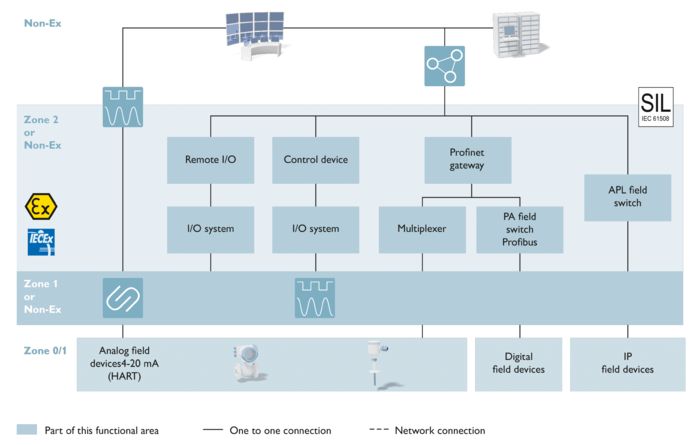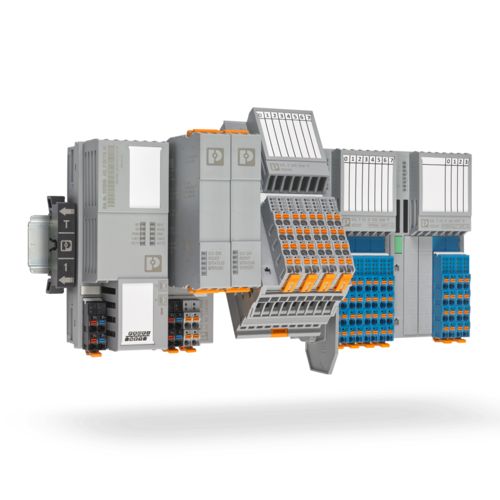Control of machines and systems in the process industry
Control systems in the process industry manage complex applications, often in critical environments. COMPLETE line provides efficient solutions for the maintenance, conversion, and retrofitting of existing applications as well as for the development of new, future-proof systems.
Structure of control systems for the process industry

One of the main tasks for the controller in the process environment is the connection of sensors and actuators in the field to the controller in compliance with all necessary safety requirements as well as the Ex approvals for various standards and zones.
One possibility is the classic point-to-point connection with products from the field of connection technology and signal conditioning. Analog signals are collected in the field via distribution boxes suitable for the environment and transmitted via trunk cables to the control room with a higher-level control system. This solution is used in the process industry in almost 80% of all cases, in particular in the oil and gas industry.
As the size and complexity of the application increases, so does the amount of wiring required. This is one of the reasons for utilizing decentral systems with industrial network connectivity. These systems are also still frequently based on analog sensors and actuators, even though control technology is increasingly using digital signals.
In the chemicals and pharmaceuticals industry, a remote I/O system is often used to collect the data. These systems usually have approval for zone 2 or even zone 1. They record analog data close to the process and enable efficient connection to the control system via the digital bus. The Axioline P station is ideally suited for combination with I/O systems with and without Ex approval and under harsh ambient conditions as well as in the temperature range -40°C to 70°C. This solution significantly reduces the wiring effort compared to classic point-to-point wiring.
A modular automation concept controls loads such as compressors and pumps. A decentral control system processes the collected data directly in the application and forwards only the data relevant to the control engineering system. This reduces the data flow and increases the speed of the system.
An end-to-end digital solution is provided by the combination of digital field devices, PROFIBUS PA field switches, and a PROFINET gateway. While the field switch supports connection and communication with digital devices, the Profinet gateway enables redundant communication with the control level. This paves the way for the connection of cloud-based asset management systems.
Even modern systems are generally based on a mix of digital and analog field devices. In this case, multiplexers support the connection of conventional I/O signals to the existing PROFIBUS PA network. They connect 4…20 mA sensors to the PROFINET gateway and make analog signals available digitally. They thus enable the sustainable use of existing analog systems with new digital sensor technology.
The new “Advanced Physical Layer” APL technology enables a direct Ethernet connection of the field device and thus eliminates the need for protocol conversion. In addition, it enables the use of further data from the field devices and forwards it to each defined stakeholder in the system. The protocol-independent APL field switch is designed and approved for operation with functional safety in potentially explosive areas and establishes safe connections to zone 0/1 APL devices in accordance with the 2-WISE standard.










